Demon is an episode with some interesting ides that cannot make up for a lackluster execution.
The writing staff on Star Trek: Voyager had been playing with the idea at the heart of Demon for quite some time. It had been a candidate for the third season finale, before Brannon Braga settled upon the story that would become Scorpion, Part I. It was considered for a mid-season two-parter, but the writing staff could never come up with a way to make the story work; Year of Hell, Part I, Year of Hell, Part II, The Killing Game, Part I and The Killing Game, Part II were all written to fill gaps left by a story that refused to materialise.

Spaced out…
As such, there is a faint scent of desperation to Demon. The episode arrives in the final stretch the fourth season, at a point when the production team is very clearly fatigued and where writers are generally desperately grasping for anything resembling a workable story. The harsh production cycle of television means that the start of a twenty-six episode season can be planned over the summer hiatus, but that the tail end of the season is typically assembled on the fly. This is the stretch of the season where even Star Trek: Deep Space Nine produces Profit and Lace or Time’s Orphan.
The problems with Demons are compounded by the fact that it is very obviously a budget-conscious show. While it features a number of elaborate computer-animated sequences, it also films primary on standing sets and features no credited guest stars. The result is a curiously plodding show, one full of extended dialogue scenes that inform neither plot nor character, and which feel like a conscious attempt to sideline the more ambitious elements of the story. The result is the waste of an interesting idea on a forgettable episode.

Something’s wrong here, though Torres can’t quite put her finger on it.
The idea of mimetic lifeforms is very clever. They are certainly a unique addition to the Star Trek canon, something very distinct from the stock bipedal humanoids with funny foreheads. There is something uncanny about an alien organism that is consciously copying another living being, the same way that the Founders are unsettling for assuming familiar forms. Indeed, there is something even more unnerving about an alien that has copied an individual so perfectly (and so precisely) that they believe themselves to be that individual.
Demon even goes so far as to suggest that these mimetic life forms are unaware of the nature of their existence, something more thoroughly explored in Course: Oblivion. These are copies so convincing that even they are convinced. This taps into one of the recurring themes of nineties culture, the paranoia about the self and the nature of reality. After all, how can person ever be sure that they are who they believe to be? demon!Paris and demon!Kim seemed fairly certain of their own identities.

Fluid spaces.
As such, the mimetic life forms feel like a worthy creation for Voyager, a show very much engaged with the cultural anxieties of the decade. Even more than Deep Space Nine, Voyager engaged with questions of memory and identity that reflected a broader fin de siècle unease. Nineties popular culture was populated with individuals learning that their lives were false, from the black-and-white residents of Pleasantville through to computer simulations in The Thirteenth Floor to the minds floating in the digital soup in The Matrix.
Repeatedly over the course of Voyager, the audience is confronted with copies and duplicates of the crew. The exact copy in Deadlock, the holographic avatars in Worst Case Scenario or Author, Author, the perverted history of Living Witness, the con artists of Live Fast and Prosper, the future Janeway from Endgame. There is a recurring anxiety across the run of Voyager about what is real, and about whether the characters themselves can ever actually be sure.

Immaterial.
Given how richly these mimetic life forms tap into that vein of cultural identity crisis, it is no surprise that the idea had been sitting around the Voyager writers’ room since the end of the previous season. Joe Menosky outlined the origin of the episode to Cinefantastique:
Menosky explained that the story of mimetic aliens had been floating around for years. Every time he and Braga started to work on it, they couldn’t do it. Menosky recalled, “Brannon had some great images. One was opening with Voyager above Earth, this great homecoming sequence. There are fireworks in the sky, and everybody is going down to their homecomings. Janeway has a wonderful tearful reunion with Mark. She kisses Mark and she then snaps his neck, end of teaser. Then he had this image of like a thousand Voyagers converging on Earth. Somehow, these duplicate Voyagers were being created that didn’t even know who they were. Writing the teleplay, it just didn’t seem to work. We shelved it, and did Scorpion instead. Fourth season, for November sweeps, we pulled out the mimetic show as a possible two-parter. Again at the last possible moment, we threw out he mimetic aliens, and came up with Year of Hell. Months later the same thing happened with The Killing Game. The mimetic aliens got to have this really weird reputation as being a negative muse. It was this weird thing floating around that no one wanted in the room. Eventually, someone came up with this idea, it might have been Ken for Demon, toward the latter part of the fourth season, not as a two-parter, but as a single episode.”
It is a good idea. It is such a good idea that the production team felt comfortable revisiting it in the fifth season with Course: Oblivion, an episode that hews even closer to that basic set-up. Demon is certainly not an episode worthy of a sequel, but the ideas underpinning the story are that good.

A low-energy effort.
There is something truly horrific in the experience of demon!Kim and demon!Paris, counterfeit people who only gradually become aware of their status as an inferior knock-off. “Captain, you have to believe me,” demon!Paris implores. “I don’t know any more than you do about this. Until he showed up, I thought I was Tom Paris. A little changed by my experience on the planet maybe, but now I don’t know who or what I am. All I know is that I have to get off this ship and go back down to the surface.”
It is a deeply unsettling notion, to lose something as fundamental as your sense of self and identity. This is a primal horror that has intrigued Brannon Braga across his work on the franchise, to the point that his first solo teleplay for Star Trek: The Next Generation was titled Identity Crisis. The fear has popped up time and again in Braga’s work, in both episodes that he directly wrote like Frame of Mind or Projections and episodes that he less directly oversaw during his time as showrunner like Latent Image or Extinction.

Ship shape.
The biggest problem with Demon is that this idea barely gets explored. The episode only even begins to reveal what happened as it rushes towards the end. There is no indication that demon!Paris and demon!Kim are imposters or replacement until the final third of the episode. As such, there is never room to develop that paranoia or build up to that reveal. Demon just throws the idea out there because it needs an impressive final twist. There is a definite clumsiness to the episode, a sense that Demon was sutured together from left-over parts of various story ideas.
To be fair, this is how Voyager tends to approach storytelling, tending to develop one plot thread only to swerve into another rather than following the original to completion. Alter Ego begins as a story about Harry Kim falling in love with a hologram only to develop into a story about a psychotic stalker targeting Tuvok. Displaced starts as a weird space phenomenon mystery before devolving into a stock “retake the ship” narrative. Worst Case Scenario opens as a critique of Voyager‘s creative direction before turning into a stock holodeck malfunction story.
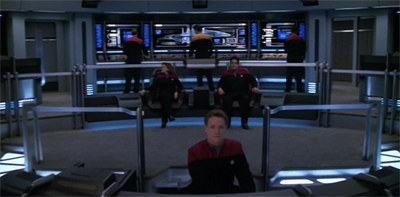
Staying on course.
Demon hybridises the notion of these mystical doppelgangers with another intriguing science-fiction high concept from Kenneth Biller, the idea of a semi-sentient biosphere that effectively terraforms life forms. As Biller explained to Cinefantastique:
“It’s a Planet Hell show. It has a spin on terraforming, the idea that humans could go to a planet that is not hospitable, and reconstruct it to become a hospitable environment. This is a story about a planet that seemingly is bioforming. It’s called a Demon class planet by Starfleet, and no one has ever survived on one. It’s got a poisonous, gaseous atmosphere. It’s an incredibly horrendous place. It transforms some of our crew members so that they can actually exist and breathe the previously poisonous (air).”
That is a remarkably clever twist on a stock science-fiction plot, a clever inversion of a narrative device that the Star Trek franchise takes for granted. The characters in Star Trek frequently alter the environment to suit their needs, but what if they met an environment that could modify them to suit its needs?
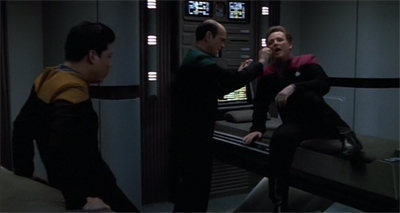
Putting the matter to bed.
“From what I can tell, you’ve been bioformed,” the EMH explains to Kim. “Think of it as the opposite of terraforming. In the same way we adapt the environment of a planet to suit our needs, this planet has adapted you.” It is a fascinating a terrifying concept, but in some ways the logical extension of the “sentient planet” that populated science-fiction from the genres roots. Indeed, the idea of a self-aware planet is arguably just an extension of the concept of a living island, an element that recurs in folklore as early as The Physiologus, if not earlier.
This plays into that uncertainty about identity, suggesting that demon!Paris and demon!Kim are quite literally products of their environment. The episode becomes uncomfortable when it begins to seem like the planet has affected and altered their psychology as much as their biology, implying that demon!Paris and demon!Kim have been conditioned to want to live on this terrifying hunk of rock without even realising that anything is amiss.

Homecoming.
“I think it’s breathtaking,” remarks demon!Kim of the planet surface. “To me, those geological formations are a dozen shades of red and gold. That dust, it’s glowing. And the haze, it seems to intensify the colours. I’m sorry. I know it’s weird, but I feel connected to this place.” Seven flags the obvious issue for the audience, “Perhaps your recent experience has impaired your perceptions.” It sounds like a crude put-down about demon!Kim receiving brain damage from exposure to the elements, but it hints at something deeper and more uncomfortable.
“You said you have a connection to this planet,” remarks Janeway at the climax of the episode. “You talk about it like it’s alive.” demon!Kim responds enthusiastically to the notion. “Alive,” he repeats. “Yes, but not the planet. The silver blood.” He elaborates, “The planet and I, we’re connected somehow. I can’t explain it, Captain. I only know that you’ve got to stop.” demon!Kim and demon!Paris are of one with the planet, perhaps similar to the relationship between the bacteria that inhabit the human digestive tract.
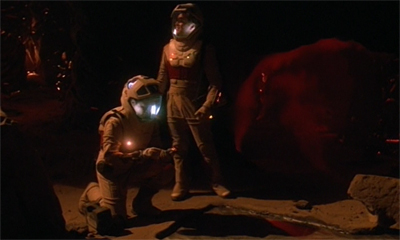
Pooling resources.
Again, this is a notion that is very much in touch with the popular conscious of the nineties. The relationship between mankind and the environment came into focus during the nineties. As John Elder reflected on the growth of environmental studies during the decade, there was particular interest in the relationship between mankind and their environment:
“I think we begin by teaching about the physical environment,” Elder said. “The geology, the weather patterns, the plants and animals that thrive in a particular region. But we also need to include human beings as part of the landscape, which means paying attention to indigenous cultures and stories of immigrations.” Like almost everyone I have talked to on this subject, Elder referred to recent nature writing as one of the liveliest corners in contemporary American culture. “We have a renaissance on our hands,” he said, mentioning the work of Annie Dillard, Edward Abbey, John McPhee, Scott Russell Sanders, Barry Lopez, Vicki Hearne, Terry Tempest Williams and Gretel Ehrlich.
Although the modern movement traces its roots to the sixties and seventies, it become more mainstream at the turn of the millennium. Artists and writers engaged more readily with the existential implications of this environmentalist philosophy.
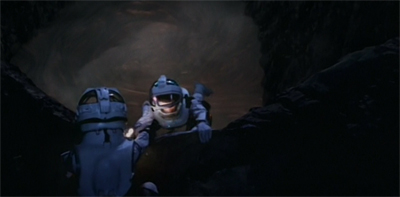
Hang on in there.
In particular, the relationship between demon!Kim and the planet feels like an extension of the classic Gaia Hypothesis. That environmental theory proposes that Earth is analogous to a living organism, with a series of closely-linked and inter-dependent systems in place. According to this school of thought, humanity exists in a dynamic relationship with other living organisms. There is a delicate balance to be maintained, tying the fate of the entire planet to any number of complex individual factors working in harmony.
This environmentally-conscious idea developed during the sixties, along with a lot of the modern environmental movement. The theory was even extrapolated on a galactic scale in The Immunity Syndrome. However, it enjoyed something of a renaissance during the nineties. These previously fringe ideas became more accepted and established, much like the new age spirituality that informed Tattoo and Sacred Ground.
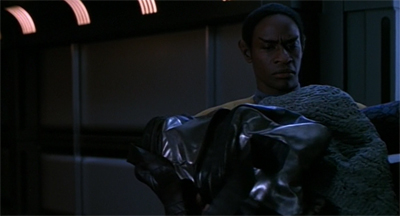
Tuvok is a wet blanket.
Although originally controversial and divisive, the Gaia Hypothesis had seeped into the popular consciousness by the final decade of the twentieth century:
The notion that living organisms were profoundly connected she would soon write large with the Gaia hypothesis, which holds that the earth is a self-regulating entity that maintains the terrestrial and atmospheric conditions that make life possible. Originally viewed as wildly unscientific, the idea has, over the 20 years that Margulis has helped nurture and tweak it, slowly lost some of its heretical edge and even gained support in certain quarters — if not as a falsifiable theory then as an innovative lens through which to view the natural world. In their models of global ozone change, the recent Nobel laureates F. Sherwood Rowland, Mario Molina and Paul Crutzen inadvertently expanded on Gaian ideas. And now that Washington has even begun to accept global warming as fact, more and more scientists are peering through the same Gaian lens.
It is worth noting that Lynn Margulis was married to Carl Sagan, who was the father of Voyager writer Nick Sagan. As such, the Gaia Hypothesis is almost part of the Star Trek family.
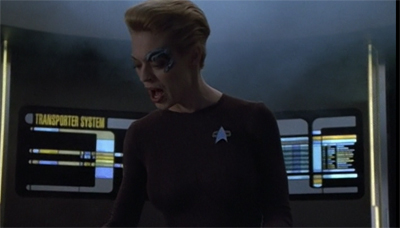
It all goes up in smoke.
So this is another clever idea in Demon. The only problem is that the two clever ideas ultimately cancel one another out. Demon at first suggests that the planet has dramatically altered Paris and Kim in order to make them suitable inhabitants for this desolate world. However, it is promptly revealed that the planet has actually made copies of the two characters who have been changed in certain ways, but aren’t aware of that until they kind of are. It is a very messy transition, and it comes far too late in the episode to really work.
To be fair, the awkward collision of these two potentially interesting plots reflects a bigger issue with Demon. The episode feels conspicuously like a “kitchen sink” episode, a desperate attempt to fill forty-odd minutes of airtime by just throwing a bunch of ideas at a wall without developing any of them. The script then transitions through those ideas as quickly as possible, hoping that the number of awkward shifts will create the illusion of forward momentum.

Deep space demon.
For example, the title of Demon refers to the classification of the planet. The planet in Demon is a class Y planet, in contrast to the franchise’s long-favoured class M template. This class of planet is is known colloquially as “demon class” in Starfleet, which seems like a surreal choice for an organisation as pointedly atheistic as the twenty-fourth century version of Starfleet. Then again, perhaps it got the nickname at some point between Who Mourns for Adonais? and Bread and Circuses, when the Federation seemed more open to such ideas.
The demon class planet is a ridiculous element to just drop into a story that is already so crowded, because it feels like such a shallow concept. It is a lazy attempt to create stakes, by having the characters repeat just how dangerous the environment must be. “Need I remind you, Ensign, that there is no environment less hospitable to humanoid life than a class Y?” Tuvok asks Kim in the staff briefing. Yes, it is so serious that even the stoic Tuvok is concerned. Naturally, what appears on screen is somewhat underwhelming.
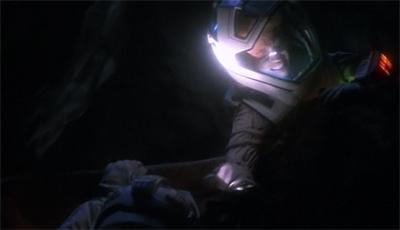
It would have made one underwhelming cliffhanger.
After all, the surface of the “demon class” planet is the same planet set that has been used on the Star Trek franchise dating back to The Next Generation. The characters (mostly) wander around in expensive hand-me-down space suits from Star Trek: First Contact, but the episode never tangibly sells the danger of the planet surface. The audience never feels the heat or the radiation or anything else. Tellingly, that same planet surface set seemed much more hostile when it appeared at the climax of Waltz earlier in the year.
The very notion of a “demon class” planet is an attempt to be transgressive, to put the audience on edge without actually doing anything. In some ways, it is similar to the plot device in The Omega Directive, an element that is notably incongruous with the larger Star Trek universe as seen to this point and which pushes some certain ideas to an extreme. What if there was a secret ominously-named rule more important than the Prime Directive? What is there was a secret ominously-named class of planets actively hostile to human life?
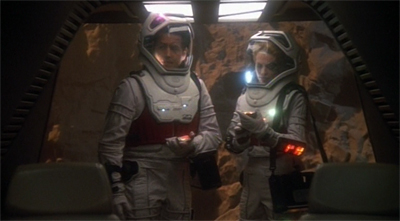
You know a Voyager episode is underwhelming when they can’t even trash a shuttle properly.
Of course, the truth is that most alien planets would be hostile to human life. The mean temperature on Venus is almost seven-hundred-and-fifty kelvin, one-and-a-half times hotter than the planet in Demon. Astronauts planning to visit Mars will have to contend with the threat of radiation to their person. When scientists discovered seven Earth-type planets in February 2017, they found that the environments were still actively hostile to human-type life even within that narrow band. As such, Demon makes a big deal out of what should be fairly common.
Similarly, Demon tries to raise the stakes even further by opening with the threat of a deuterium shortage on the ship. This forces the crew to ration energy. Ignoring the fact that Voyager should be dealing with these sorts of problems on a regular basis owing to their situation as the only Federation ship in the Delta Quadrant, the crisis feels unearned. The shortage was not set up in earlier episodes like Unforgettable, and it is handily resolved at the end of Demon. It is a cynical and transparent plot device, much like the “demon class” planet.
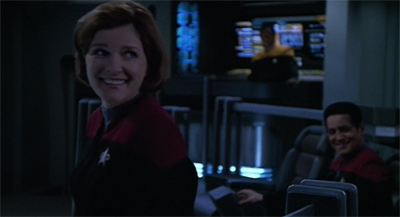
Smiles to go.
The result is a primary plot that is driven on a series of absurdly heightened contrivances. It just so happens that Voyager is running low on deuterium, despite no indication of that problem at any point in the previous season. It just so happens that the only source of nearby deuterium is on a “demon class” planet, a planet classification so dangerous and deadly that it had never been spoken aloud before. It just so happens that this “demon class” planet can transform people to fit the environment. It just so happens that it has actually been making clones.
It is a very slipshod approach to plotting, one that hints a late-season desperation. This is the point in the season where episodes like Through the Looking Glass, Shattered Mirror, The Muse, Twisted, False Profits and Favourite Son seem like a good idea. There is a deadline that needs to be hit, and sometimes the only way to hit that deadline is to bundle up a bunch of leftovers and just throw them into a pot while desperately hoping for the best. Indeed, the problems with Demon are compounded by the fact that it seems to have been designed as a bottle episode.
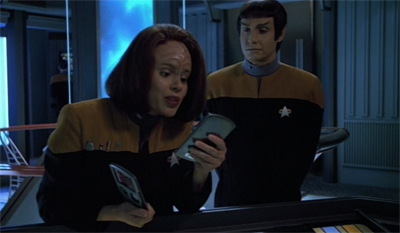
Torres seems remarkably comfortable having her would-be rapist quote her boyfriend back to her.
To be fair, the fourth season of Voyager had been very ambitious and expensive. The fourth season embraced blockbuster storytelling sensibilities, taking advantage of advances in computer-generated imagery to offer a more epic canvass. Scorpion, Part I and Scorpion, Part II introduced Species 8472, an alien species rendered entirely in computer animation. Year of Hell, Part I and Year of Hell, Part II shredded the standing Voyager sets and featured epic battles. The Killing Game, Part I and The Killing Game, Part II recreated the Second World War… with Klingons.
Even the standalone episodes were impressive in their scale and ambition. Prey marked the last episode to feature Species 8472 in their original form, pitting them against the Hirogen. The fourth season featured any number of notable guest stars, from Kurtwood Smith to Andy Dick in Message in a Bottle to John Rhys-Davies in Concerning Flight. Even Living Witness was an expensive episode, involving an expansive guest cast and considerable make-up and set alterations. So it was not as if Voyager had been investing its production budget poorly.
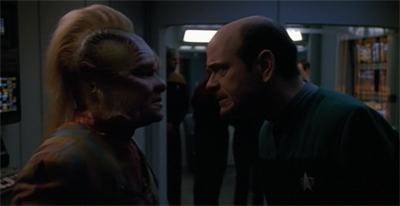
They won’t see eye-to-eye on this.
At the same time, Demon is not a story that lends itself to the bottle episode format. The episode features no credited guest stars, and uses standing sets. One of the problems with the surface of the “demon class” planet is that the show makes no real attempt to disguise the familiar “planet hell” sets. While there are some practical effects, most of the scenes on Voyager itself simply turn the lighting way down. Indeed, it seems possible to read the deuterium shortage that drives the episode as a metaphor for the budgetary concerns.
To be fair, there are some impressive computer-rendered shots that undoubtedly ate into the budget. Voyager loses another shuttlecraft, although the episode cuts away from the crash to Paris and Kim wandering around the surface in their environmental suits; when Chakotay and Seven discover the crashed shuttle, it is a stock set with no real sense of damage or destruction. Voyager itself lands on the surface of the planet, the first time that the ship has set down on an alien world since Basics, Part II. However, these shots exist quite apart from the actual practical shots.
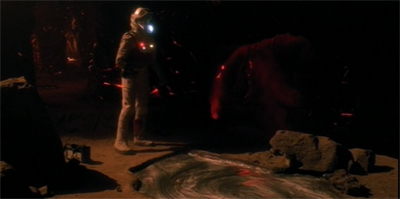
Mercurial.
These budgetary concerns lead to other compromises, such as a weird character focus in the midst of this big broad science-fiction epic story. There is a bizarre little subplot running between Neelix and the EMH that doesn’t go anywhere, instead designed to serve as comic relief about their “odd couple” relationship when forced to room together. However, that comic relief is very much at odds with the stakes in the other story thread, the suggestion that Voyager is dying while Paris and Kim have been transformed into something alien.
The episode also includes a lot of material between Paris and Kim, harking back to the early attempts to establish a relationship between the two characters in episodes like Caretaker, The Cloud or Non Sequitur. However, much like the dynamic between Chakotay and Janeway, the relationship between Paris and Kim had been largely neglected during the third and fourth seasons. Indeed, Paris’ strongest relationship was now with Torres, a relationship that would eventually lead to marriage and parenthood.
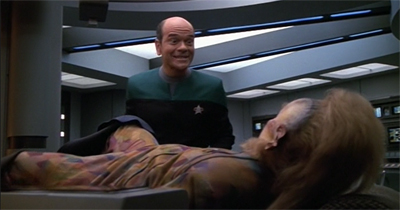
A wake-up call.
Demon tries to suggest some character development for Kim, having him make a bold stand in a meeting and even sarcastically smacking down Tuvok. Harry reflects that he was introduced as the “baby” character on the show, the young green-behind-the-ears new recruit, like Wesley or Bashir. “I was young, inexperienced, and I acted like it,” he reflects. “Nervous about giving my opinion, hesitant to make suggestions, so I usually just kept my mouth shut. And I behaved that way for so long it became a habit.”
However, as Kim concedes, that template cannot remain in place forever. An inexperienced person can only have so many experiences before they become experienced through exposure. After all, Bashir grew and evolved over the seven years of Voyager. Kim alludes to this reality, “But, in the last four years, a lot has happened. I’ve fought the Borg, been transformed into an alien, helped defeat the Hirogen. Hell, I’ve even come back from the dead.” Paris agrees, “It’s been a wild ride.”

Harry on regardless.
Kim’s conclusion makes a great deal of sense. “I woke up the other morning and it suddenly hit me. I’ve got a lot of experience now, so why should I be afraid to take the initiative or voice my ideas?” However, there are several problems with how Demon makes this argument. Most obviously, there has been little indication of actual growth on Kim’s part over the past four years. He assertiveness in Demon is striking because it is so out of character with everything that has been established about the character to this point. These conversations feel like telling more than showing.
More to the point, none of these arguments made in Demon are allowed to stick. Demon does not represent the origin story of a new and exciting version of Harry Kim, a version of Harry Kim who has a clear sense of purpose and self-confidence. Instead, he gets stuck repeating the same storybeats. In the fifth season, Harry Kim is as naive about alien sexuality in The Disease as he was during Favourite Son in the third season. In the final season, Nightingale is essentially a story about how Kim is still inexperienced.
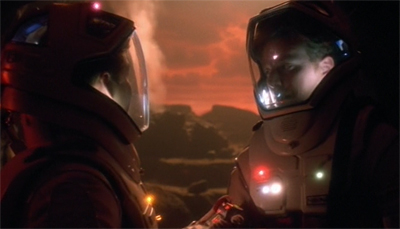
Stepping out of his comfort zone.
Wang acknowledging how frustrating this approach to the character could be, lamenting in interviews:
Kim was probed, beaten, tortured and held the distinction of being the first Voyager crew member to die and come back to life. What more does a guy have to do to get promoted to Lieutenant for frak’s sake? To add further insult to injury, other crew members such as Tuvok (Russ) and Paris were being promoted, demoted and then re-promoted throughout the seven-year run of Voyager.
I’m not trying to be negative here; just saying it like it is. During the fourth season, I called writer/producer Brannon Braga and asked him why my character hadn’t received a promotion yet. His response? “Well, somebody’s gotta be the ensign.” Geez, thanks. Thanks for nothing.
It’s hard not to empathise with Wang in this situation.

Red sky in the morning is a writers’ room warning.
Kim was undoubtedly a neglected character, and Demon feels like an ill-fitted band-aid applied to a chronic wound. If anything, it just draws attention to how neglected and underdeveloped the character had been to this point. In the absolute best case scenario, it shunts necessary character devolopment off-screen and becomes a soft reboot of an established character rather than an organic development. As it eventually played out, it is a soft reboot that never really takes hold, with Kim casually reverting back to his preexisting template immediately.
Indeed, the Paris and Kim subplot in Demon feels passive-aggressive on the part of the writers, including several jabs at the actors for their (slight) weight gain over the previous season. Paris’ suggestion that the crew set up an exercise bike manned by Kim to power the ship is slightly pointed, as is the banter as they make their way back to the ship with the leaking suit. “Have you put on weight?” Tom asks. Kim responds, “You’re just out of shape.” Paris promises, “You hold your breath till we get back to the shuttle and I promise I’ll start exercising every day.”
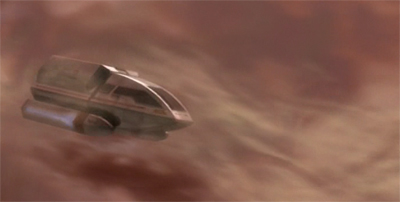
“Sure, we’re low on resources. But we can probably spare a shuttle.”
As Wang explained to The Fifty-Year Mission, these plot elements were intended as a none-too-subtle message to the actors from the producers:
The writers were very passive-aggressive. When they’re upset with you, they write it into the script. When Robbie, Robert, and I got heavy one season – we were eating all the junk food on set and gained like twenty or thirty pounds – they gave us girdles to flatten our stomachs. In this one scene in one episode, McNeill and I are in our spacesuits trying to make it across this rocky terrain. Paris is helping me and we’re both gasping for air, and he says, “Promise me one thing, Harry. If we make it back alive… you’ll work out.” Later I called Brannon Braga and I said, “What’s this crap int he script about working out man, is that a dig?” And Brannon said, “Well, Garrett, if you and your fellow actors go down the same path eating the way you have for the past two years, we’re going to have to change the name of the show to Star Trek: Voyager – Pigs in Space.”
That is a decidedly unprofessional attitude from a writer on a television series, particularly one who would soon be overseeing the day-to-day production.
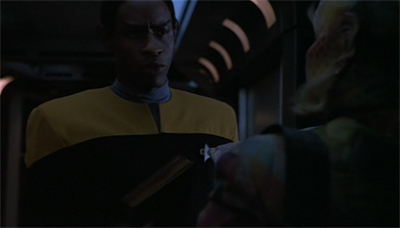
Tuvok is very by the book.
Braga might have been one of the strongest writers working on Voyager, but he was still a relatively inexperienced producer. This inexperience would cause all manner of problems during his tenure as showrunner. It showed in the power imbalance that existed between Braga and franchise overseer Rick Berman, particularly when contrasted against with relationship that Berman had with more experienced producers like Michael Piller or Ira Steven Behr. This was part of the reason that Voyager never pushed as far as it really should have.
However, Braga’s inexperience also showed in other areas during the production of Voyager. Most notably, he had a very confrontational and juvenile attitude towards many of those working for him. Ronald D. Moore has talked about how the lower-level writers on Voyager were effectively bullied by those more senior. Writers have told horror stories about pitching for Braga, and Braga has acknowledged that he did not always conduct himself in the most professional manner. His relationship with actors like Garrett Wang and Robert Beltran is part of that.
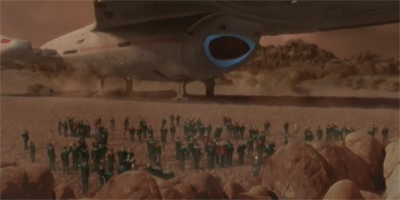
Sticking the landing.
In some ways, this is the biggest issue with Demon. For all the interesting ideas at play and all the clever concepts baked into the story, the most intriguing part of the episode is perhaps the passive-aggressive sniping between the production team and the actors, an indication of just how toxic the behind-the-scenes environment had become.
Filed under: Voyager | Tagged: bottle episode, Demon, demon class, garrett wang, harry kim, kenneth biller, planet hell, star trek: voyager, voyager |




















I always wished that I could have seen Harry Kim’s face when he gets back to Earth, still an Ensign, while Nog, a waiter when he left, has become a lieutenant and a war hero. I do believe that this episode is the one that starts the trend of giving Harry one episode per season where he becomes sick of being the naive ensign only for him to revert back to the status quo immediately after the episode.
For me, the episode has many flaws beyond the cluttered plot, thought admittedly that is the biggest problem. I can’t take the silver goo seriously, as that is just too preposterous. If it could just copy the person, I would be somewhat willing to accept it, but that it can also give the person the exact same memories is just too ludicrous for me. Another problem, is Janeway’s decision to allow the silver goo to make copies of her entire crew, and presumably also Voyager. This just makes no sense, as surely she would realize that this could lead to serious ramifications, and it is not like she was in serious danger, as she was during the Hirogen incident.
I did like the nice touch of Janeway at least seeking the crew’s consent before handing over their DNA to the alien species. I have less of an issue with it being a consensual thing, because I feel it’s fair for somebody to get to choose if there’s a clone of them stuck on some rock somewhere.
And, to be fair, there’s a suggestion that they are really just enabling the awakening of some primitive intelligence, helping it come into being. The idea in Demon is that the bodies would be tied to the planet, and would even share a consciousness with it.
There’s no indication in Demon that Janeway was letting them clone Voyager itself. And, as much as I like Course: Oblivion, it involves a fairly significant rewrite of the end of Demon.
Eh episode except…for the Doctor and Tom & Harry: for some reason they rewound the Doctor to season 1 and made him insufferable. Just ridiculous. And the banter between Tom and Harry almost made my ears bleed. So fake and awkward.
It’s just a mess of an episode, from beginning to end.
I’ve been going back through the Star Trek series I haven’t completely watched, starting with Voyager. I have been consistently impressed with the writing of the series.
Good Lord, did THAT ever hit a screeching halt on this one. Brutal dialogue. Utterly cardboard characters. It took a fair bit of determination to get to the end of this episode. Hoping that was the only major miss; we’ll see. Onward!
This episode is interesting. There are finger-prints of some new or outsider writer here. We have dialogue scenes between characters that are not directly related to the plot, which is extremely rare. We have Harry Kim expressing a level of actual self-awareness with regard to his experience and status on Voyager. We have Kim saying slang like “Laaaame” to Paris, and Chakotay uttering phrases like “What’s up?” The banter feels like an attempt to craft more human dialogue and moments that aren’t about some anomaly, technobabble, or action scene.
Sadly, Tuvok remains a punching bag. But even he gets a line where he states that it’s not worth itemizing the ship’s damage, and just concludes that Voyager will need a lot of repair work.
I think there was a new person in the writer room who has not appeared in the credits here, and that there was an attempt to create a number of human interactions – between Tom and Harry, Neelix and the Doctor, Chakotay and Torres.
The science in the episode makes no sense, but I think this episode showed a rare flash in the pan attempt at fleshing out character dynamics. It was promptly dropped of course.
The information about Braga calling Kim and the others fat is crazy, especially considering how he dated Jeri Ryan later. I get Weinstein vibes, even if I’m sure it was nothing like that. The abuse of power still seems to have been a factor that poisoned the well of Voyager. The danger of ego…
Did this comment get through?
Yep, looks like it did.
As we’re nearing the finish line this season, Demon decides to remind the audience that Voyager is cut off from Federation support, and that as a result, supplies are running low. But like the way S3 failed to keep the Borg threat looming on the horizon, Voyager’s deuterium shortage is just something sprung on us out of the blue and then quickly forgotten about by Demon’s end.
Perhaps realising that a fuel shortage by itself doesn’t make for the most exciting plotline, Demon comes up with a whole other plot about the only fuel source available to the crew is on a planet so hostile to human life, Starfleet have designated it Demon-class, and not only that, it’s a substance that creates perfect living copies of whatever it comes into contact with.
Demon is a classic case of too many ideas and not the proper time to explore them all. Being forced to gather supplies from a dangerous planet has potential, like Resistance in S2, but Demon’s budget limitations severely hampers that. Not for one moment are we ever convinced that this is a real planet Tom and Harry, and then later Chakotay and Seven of Nine are exploring. We’re reminded by the characters that the place has a toxic atmosphere, forcing them to wear spacesuits, but it’s painfully obvious this rescue mission is all taking place on stock sets.
And that’s all before we get to the real meat of the story, Tom and Harry’s duplication. Setting aside for the moment the episode’s total disregard for any of the ethical implications of cloning (that would have to wait for Course: Oblivion to witness the full horror of what the crew have done), the fact that a potential fuel source would have mimetic properties is too unbelievable, much less endow those clones with sentience and an identical personality.
Even after discovering that the Silver Blood can reproduce other forms of life, it’s uncomfortable that the crew still intend to use that substance to get Voyager up and running again. It’s times like this you see the lengths Janeway will go to get home if the situation is desperate enough (something that will come back to bite Janeway in Hope and Fear).
What’s really missing from Demon is a palpable sense of impending doom, like the feeling the crew will be stranded on a Y-class planet forever. But the scenes aboard Voyager are remarkably bereft of tension. We have Torres and Vorik (of all people!) discussing the complete loss of life-support, only to follow it up with her being impressed with Vorik’s use of some of Tom’s 20th century lingo. As well as a ludicrous subplot of Neelix trying to get his head down in sickbay, leaving the Doctor frustrated with his unwanted company.
It’s annoying that the crew fully expect what should be a life and death situation to be fully resolved by the time the credits are rolling. Demon could have been an episode that brought home to them the message of what a harsh situation it is to be stranded halfway across the galaxy, but like most of VGR’s crises, it’s another case of “been there, done that.”